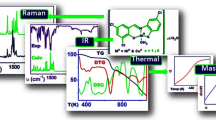Abstract
The informative capacity of thermal analysis in the evaluation of the thermal stability of coordination compounds involving the evolution of volatile ligands is discussed. The temperature of decomposition under quasi-equilibrium conditions (Q-derivatograph, quasi-isobaric, quasi-isothermal operation) is suitable for characterizing the thermodynamic stability of compounds. The initial temperature of decomposition at linear heating indicates the reaching of a defined value of the rate constant (depending on the sensitivity of the sensing device of the instrument and on experimental conditions). The temperature sequence of increasing thermal stability may not coincide with the sequence of increasing activation energy values, since in the majority of cases it demands on the value of activation enthropy.
Résumé
L'aptitude de l'analyse thermique à servir de source de données pour l'évaluation de la stabilité thermique des composés de coordination lors des réactions de décomposition mettant en jeu l'élimination de ligands volatils est discutée. En conditions de quasi-équilibre (Derivatograph-Q, opérations quasi-isobares, quasi-isothermes) la température de la décomposition thermique peut Être utilisée pour caractériser la stabilité thermodynamique des composés. La température du début de la décomposition en chauffage linéaire indique l'obtention d'une valeur définie de la constante de vitesse (qui dépend de la sensibilité du dispositif détecteur de l'appareil et des conditions expérimentales). L'ordre de succession des températures définissant l'augmentation de la stabilité thermique peut ne pas coincider avec celui des valeurs de l'énergie d'activation, puisque dans la majorité des cas il dépend de la valeur de l'entropie d'activation.
Zusammenfassung
Die informative Kapazität der Thermoanalyse bei der Bewertung der thermischen Stabilität von Koordinationsverbindungen in Thermolysevorgängen unter Entwicklung flüchtiger Liganden wird vorgestellt. Die Temperatur der Thermolyse unter Quasi-Gleichgewichtsbedingungen (Q-Derivatograph, quasi-isobare und quasi-isotherme Prozesse) eignet sich zur Charakterisierung der thermodynamischen Stabilität der Verbindungen. Die Temperatur des Beginns der Thermolyse bei linearem Aufheizen zeigt das Erreichen eines definierten Wertes der Geschwindigkeitskonstante an (in Abhängigkeit von der Empfindlichkeit des Fühlers des Gerätes und von den Versuchsbedingungen). Die Temperatursequenz der zunehmenden Thermostabilität stimmt nicht nötigerweise mit der Sequenz der zunehmenden Werte der Aktivierungsenergie überein, da erstere in den meisten Fällen von der Aktivierungsenthropie abhängt.
РЕжУМЕ
ОБсУжДЕНА ИНФОРМАцИ ОННАь ЕМкОсть тЕРМИЧЕскОгО АНАлИж А пРИ ОцЕНкЕ тЕРМИЧЕс кОИ стАБИльНОстИ кООРДИ НАцИОННых сОЕДИНЕНИ И В тЕРМОлИтИЧЕскИх пРО цЕссАх, ВклУЧАУЩИх ВыДЕлЕНИЕ лЕтУЧИх лИ гАНДОВ. тЕМпЕРАтУРА т ЕРМОлИжА пРИ кВАжИ-РАВНОВЕсНы х УслОВИьх (Q-ДЕРИВАтОгРАФ, кВАжИ-И жОБАРНыИ, кВАжИ-ИжОтЕ РМИЧЕскИИ МЕтОД) ьВльЕтсь пРИЕМ лЕМОИ Дль хАРАктЕРИстИкИ т ЕРМОДИНАМИЧЕскОИ ст АБИльНОстИ сОЕДИНЕНИИ. тЕМпЕРАт УРА НАЧАлА тЕРМОлИжА пРИ лИНЕИН ОМ НАгРЕВЕ ОжНАЧАЕт Д ОстИжЕНИЕ ОпРЕДЕлЕННОгО жНАЧЕ НИь кОНстАНты скОРОстИ И жАВИсИт От ЧУВстВИтЕльНОстИ пР ИНИМАУЩЕгО УстРОИстВА пРИБОРА И ЁкспЕРИМЕНтАльНых УслОВИИ. тЕМпЕРАтУРН ыИ пОРьДОк слЕДОВАНИ ь УВЕлИЧЕНИь тЕРМИЧЕскОИ стАБИль НОстИ МОжЕт НЕ сОВпАДАть с п ОРьДкОМ слЕДОВАНИь У ВЕлИЧЕНИь АктИВАцИОННОИ ЁНЕРг ИИ, пОскОлькУ В БОльшИНс тВЕ слУЧАЕВ ОН жАВИсИ т От жНАЧЕНИь АктИВАцИОН НОИ ЁНтРОпИИ.
Similar content being viewed by others
References
V. A.Logvinenko, F.Paulik and J.Paulik, Tezisy dokladov VI. Vsesoyuznogo Soveshchaniya po termicheskomu analizu. Moscow, 1976. p. 71.
V. A. Logvinenko, F. Paulik andJ. Paulik, Dokl. Akad. Nauk., SSSR, 233 (1977) 129.
J. Paulik andF. Paulik, Anal. Chim. Acta, 56 (1971) 328.
J. Paulik, F. Paulik andV. A. Logvinenko, J. Thermal Anal., 10 (1976) 123.
V. A. Logvinenko andL. I. Myachina, Izv. Sib. Otd. Akad. Nauk. SSSR, Ser. Khim., 9 (1974) 85.
A. V. Nikolaev, V. A. Logvinenko, J. Sestak andF. Shkvara, Dokl. Akad. Nauk, SSSR, 231 (1976) 146.
E. A.Prodan, M. M.Pavlyuchenko and S. A.Prodan, Zakonomernosti topokhimicheskikh reaktsiy. Minsk, 1976.
V. A.Logvinenko, O. V.Gegola, G. N.Chekhova and Yu. A.Dyadin, Tezisy dokladov soveshchaniya po kinetike i mekhanizmu khimicheskikh reaktsiy v tverdom tele. Novosibirsk, 1977, Part I, p. 150.
B.Delmon, Introduction à la cinétique hétérogène. Paris, 1969.
V. V. Barzykin, V. T. Gontkovskaya, A. G. Merzhanov andN. I. Ozerkovskaya, Proceed. IV. ICTA (Budapest 1974). 1975, Vol. 1, p. 195.
Author information
Authors and Affiliations
Rights and permissions
About this article
Cite this article
Logvinenko, V.A., Gegola, O.V. & Myachina, L.I. A comparative study of the thermal stability of coordination compounds by thermoanalytical methods. Journal of Thermal Analysis 14, 265–270 (1978). https://doi.org/10.1007/BF01915164
Received:
Issue Date:
DOI: https://doi.org/10.1007/BF01915164




